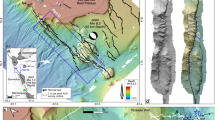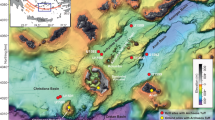Abstract
ON April 5, 1958, one of the world's largest man-made non-nuclear explosions was fired at Ripple Rock in Seymour Narrows on the west coast of Canada. Briefly, the object of the explosion, which was carried out for the Department of Public Works, Canada, was to remove a twin peaked underwater rock from the centre of a narrow seaway. The method adopted was to sink a 500-ft. shaft on a nearby island and then drive a 2,400-ft. tunnel to points beneath the peaks. Further shafts each 300 ft. high were driven upwards into the rocks and an extensive system of short tunnels was excavated so as to honeycomb the peaks. These tunnels were filled with 1,400 tons of an explosive known as ‘Nitramex 2H’ manufactured by the Du Pont Company of Canada. The general arrangement is shown in Fig. 1.
This is a preview of subscription content, access via your institution
Access options
Subscribe to this journal
Receive 51 print issues and online access
$199.00 per year
only $3.90 per issue
Buy this article
- Purchase on Springer Link
- Instant access to full article PDF
Prices may be subject to local taxes which are calculated during checkout
Similar content being viewed by others
References
Lampson, C. W., “The Effects of Atomic Weapons” (McGraw-Hill, 1950).
Author information
Authors and Affiliations
Rights and permissions
About this article
Cite this article
WRIGHT, J., CARPENTER, E., HUNT, A. et al. Observations on the Explosion at Ripple Rock. Nature 182, 1597–1598 (1958). https://doi.org/10.1038/1821597a0
Issue Date:
DOI: https://doi.org/10.1038/1821597a0
Comments
By submitting a comment you agree to abide by our Terms and Community Guidelines. If you find something abusive or that does not comply with our terms or guidelines please flag it as inappropriate.



